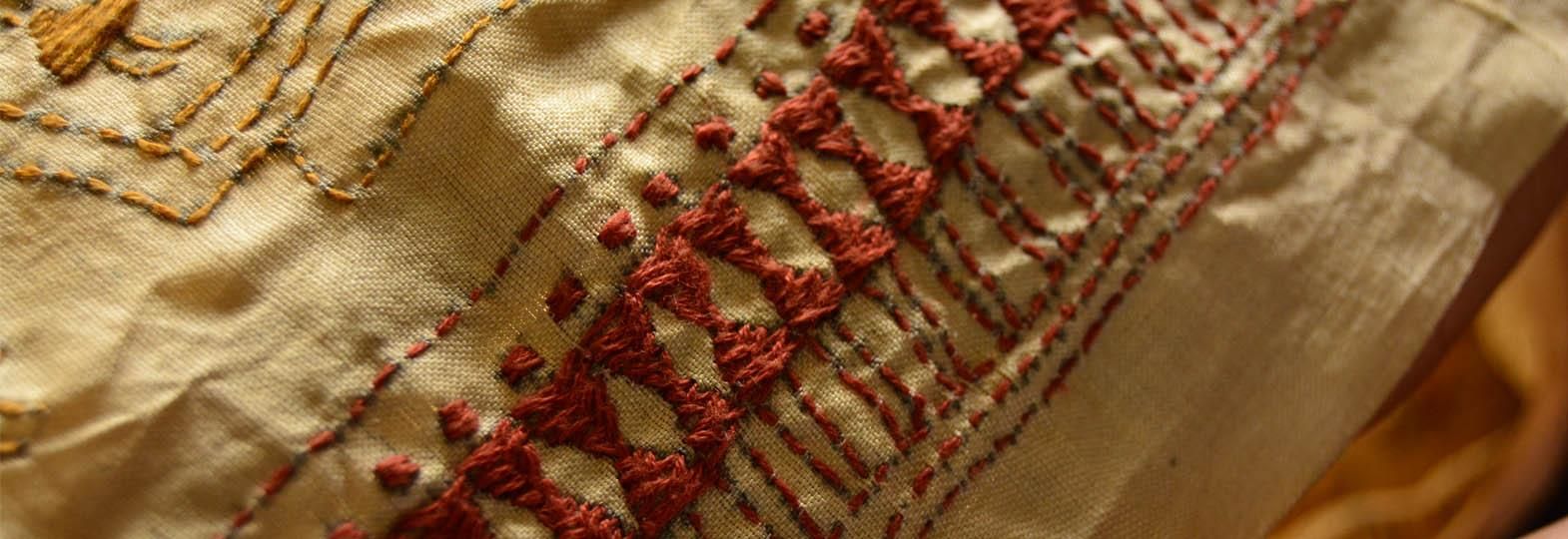Children in India’s West Bengal and adjoining areas have grown up swaddled in ‘Kanthas’ made by their mothers and grandmothers for ages. The women of the household would make these Kanthas by layering and stitching old sarees and dhotis. The multiple wear and wash cycles of these old fabrics would make them soft and comfortable. Even the threads used for stitching were the drawn-out yarns from the colourful borders. This is an example of recycling textiles at its best.
Kantha stitching is one of the oldest craft techniques in India. It dates back to the pre-Vedic times of 1500 BCE. However, the oldest documented record comes from 500 years ago in the text Sri Sri Chaitanya Charitamrita by poet Krishnadas Kaviraj. The poet narrates how Mahaprabhu’s mother sends him a Kantha to Puri. The Kantha is still displayed in the Gambhira of Chaitanya Dev in Puri.
The origin of the word Kantha comes from Sanskrit, meaning old rags. Made primarily in Hugli, Birbhum, Jessore, Faridpur, Khulna and other parts of West Bengal and Bangladesh, the technique used is a basic running stitch. Layers of old fabrics are spread together. The light-coloured fabrics are placed in the outer layers to provide a better background for the colourful stitches. Edges of the layers are first roughly stitched to keep the multiple layers of fabrics in place. The detail stitching is done next, starting from the centre and moving towards the corners. The motifs range from flowers, animals and people to religious texts and mythology. In Murshidabad, where the majority of women working on this craft are Muslims, the motifs are more geometric in shape. These patterns have evolved in line with the Islamic art form, where geometric shapes are used more than organic forms. The running stitches look almost like dots, giving the appearance of pointillism. A well-made Kantha saree or stole can look equally neat on both the face and the wrong side.
In the older days, the designs and stitching were done from memory, and no patterns were drawn. For Nakshi Kantha, the design outlines were first made with a darker-coloured thread and then filled with brighter colours. Today, the patterns are drawn by pencil on tracing paper. These patterns are then transferred to the fabric with the help of kerosine oil. Wooden blocks are also used to print the outlines.
The Kanthas were traditionally done by the rural women in the afternoons when they would get a little free time from the household chores, farming and taking care of the children. The Kanthas gave them a blank canvas where their imaginations were only the limit. Folk stories to religious beliefs, social lives to cultural festivals, dreams and hopes – everything became a part of the tale. These Kanthas were often made by multiple women, at times passing from generation to generation. These were repositories of memories.
The craft was not just limited to a specific social status. Women from both affluent and low-income families indulged in this craft. The Kantha made by a zamindar’s (landlord’s) wife might have been more elaborate in terms of the materials and threads used, yet, the detailing and the embroidery done by a farmer’s wife remained as magical. The imaginative, creative, resourceful craftsmanship is the essence of Kantha stitching.
Kantha, in old rural Bengal, was a utilitarian and essential product. It was made over a more extended period and kept by a family for personal use. These were used as lightweight covers for the mild winters. The expecting mothers would also stitch smaller Kanthas during the last few months of their pregnancy to swaddle the new-born. It was believed that this would bring about good fortune to the family and protect the baby. Other uses include covers, prayer mats, purses etc.
Kanthas are categorised into different types based on the end use. A study by Textiles of India categorises Kantha into seven types. These are
1. Arshilota – A cover for the mirror. Radha Krishna tales generally inspire the central pattern. The wider border comprises floral motifs with trees or lines.
2.Bayton or Bastani – Generally serves as a cover for books or other valuable items. A hundred-petalled lotus is a primary motif used in this.
3. Batwa or a purse – A square piece of Kantha is stitched like an envelope. Flora and fauna motifs, such as leaves and snakes, are made on such items.
4. Lep or a quilt – It is a quilted coverlet with layers of saree. Geometric or wave patterns are stitched to provide a rippled look.
5. Oar or pillow cover – As the name suggests, this is used as a pillow cover. Motifs like trees, leaves, creepers, and flowers are made along the four borders.
6. Sujni or Nakshi Kantha – This is a rectangular fabric used as a spread for festive occasions. This is the most striking piece of Kantha, where multiple artisans work together to show their creativity. Lotus motifs, along with tales from Ramayana and Mahabharata, are depicted on Sujni.
7. Rumal or the handkerchief – A small square piece of fabric used as a handkerchief. An embroidered border with small motifs is used in this.
The craft of Kantha stitching is also mentioned in several pieces of Bengali literature. One such major work is the poem ‘Nakshi Kanthar Math’ by poet Jasimuddin which narrates the tragic tale of the fateless lovers - Saju and Rupai. Lonely and melancholic Saju makes the famed Nakshi Kantha in the memory of her happy times with Rupai. Such was the importance of this craft in the Bengali culture that it got interlaced with its literature.
However, like many other artisans of handlooms and handicrafts, the makers suffer a loss of livelihood. In Shantiniketan, the current hub of Kantha work, the artisans get ₹1,500 to ₹3,000 for one saree. Making each saree can take up to six months. In addition to this, due to a lack of copyright laws, cheap duplicate products have flooded the market.
The ray of hope comes from the new-age designers who are increasingly inspired to use traditional handcrafted techniques in their products. From Delhi-based brands like Indigene to international names like Emily Bode have used Kantha stitching in their designs. Burberry’s 2015 collection called ‘Patchwork, Pattern and Prints’ showcase Kantha stitch.
The model of Kantha work is the perfect Indian example of sustainable recycling. It shows the world that instead of discarding and wasting old things, one can preserve and upcycle them to create new things. It is a model inspired by romance, heritage and memories.











Comments